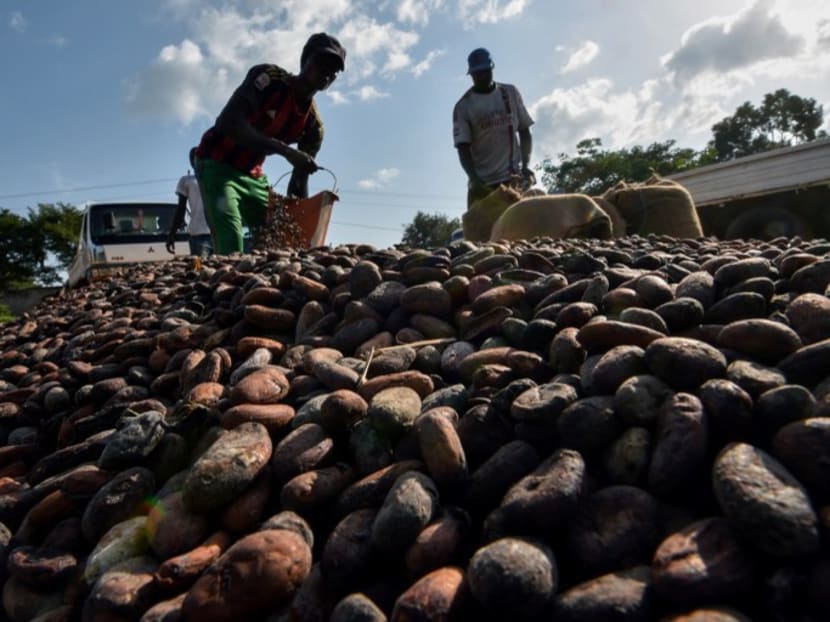The world’s biggest cocoa grower is losing its rainforests
ABIDJAN (Ivory Coast) — After disease ravaged his cocoa farm, Mr Philippe Zongo walked into one of West Africa’s last remaining rainforests to hack out new acreage.
ABIDJAN (Ivory Coast) — After disease ravaged his cocoa farm, Mr Philippe Zongo walked into one of West Africa’s last remaining rainforests to hack out new acreage.
Like thousands of young men from Ivory Coast and more arid neighboring countries, Mr Zongo set out to find the best soil to plant new cocoa trees. He found it in the western Cavally forest, an area bigger than Chicago where chimpanzees live under the canopy of trees 100 feet (30.48m) tall.
“When I arrived in the forest, the first thing I did was clear the land,” said 23-year-old Zongo. “I burnt down what I could, and I cut off what I couldn’t burn.”
It is a scenario that has defined the modern history of Ivory Coast, the world’s largest cocoa producer: trees are logged for timber, land is cleared for crops and gradually the soil becomes barren.The Forestry Ministry estimates that about 80 per cent of the country’s forests have disappeared since the 1970s. Replanting was considered unnecessary: cocoa doesn’t need shade to thrive.
LOWER RAINFALL
Cocoa, coffee and palm-oil have fueled Ivory Coast’s growth since before independence from France in 1960, making the country a model of economic stability in Africa. Ivory Coast shipped 1.8 million metric tonnes of cocoa beans in the harvesting season that ended last year, a historic peak that industry analysts a decade ago said was not reachable. But growth has come at a high price: the country faces lower rainfall and increasingly nutrient-poor soils, the US Agency for International Development said in a 2012 environmental report.
For decades, the government encouraged and even helped Ivorians and foreign migrants get access to land, a policy cemented by the 1963 dictum of the country’s longtime ruler Felix Houphouet-Boigny that “the land belongs to those who develop it.”
Today the message has changed. President Alassane Ouattara’s government has pledged to evict people from its protected parks and forests and double the remaining forest cover by 2020, Water and Forests Minister Louis-Andre Dacoury-Tabley said in an interview in Abidjan, the commercial capital.
“We’ve realised we’re heading toward desertification,” he said. “We need our forests to get rains, to be able to breathe.”
MUDDY ROADS
Yet the destruction continues at a frantic pace. Ivory Coast has the highest deforestation rate in Africa, accelerated by a 10-year conflict that eroded the rule of law and left park rangers faced with rebels or ex-soldiers who seized protected areas and began distributing patches of forest in return for illicit “taxes.” Even if the conflict ended in 2011, some forests in western Ivory Coast are still controlled by armed groups.
In 2014, two years after Mr Zongo began developing his farm, park rangers arrived to tell him the forest was protected and ordered him to leave. He said he was not aware the area was off-limits, and he is determined to stay.
“I have nowhere else to go,” he said. “If you have no job and sit around all day doing nothing, you’ll start stealing. I don’t want to end up like that.”
Reaching the Cavally forest involves more than a half-day journey from Mr Zongo’s small house on the outskirts of the cocoa-trading town Duekoue. He rides a minibus to travel two hours west on an unpaved, muddy road, then another hour on a gravel track splitting rubber plantations.
About half an hour after entering the forest on foot, tiny, almost invisible cocoa stems begin to appear. As Zongo walks on, the cocoa trees get bigger, the air feels warmer and the forest thins out.
PLANTS, ANIMALS
The Cavally forest is exceptional for its wide range of plant and animal species, and one of the last protected areas in the country that are still mostly intact. But it is also the most threatened among six forests due to the encroachment of an estimated 10,000 farmers who’ve invaded the area in the last few years, the United Nations Environment Programme said in a report last year.
When he tends to his plantation, Mr Zongo rests under a makeshift wooden shelter hammered into the forest floor, with a sheet of black plastic for a roof that he shares with 15 fellow young farmers. They say the conditions are too tough for their wives and children, who’ve stayed behind in villages at the edge of the forest.
“We often see the chimpanzees passing in the morning and in the evening,” Mr Zongo said. “We can be here, they can be here, too. They love cocoa. We often come to see the chimpanzees eating cocoa in the pods.”
Mr Zongo is counting on a significant first harvest this season. About 2 tonnes of the beans will earn him US$3,000 (S$4,172). As he showed the plantations in what used to be green, dense, humid forest, he reflected on the government’s orders to vacate the area.
“We are many people here, we are so many,” he said. “We want to stay.” BLOOMBERG







